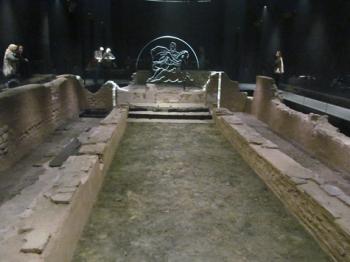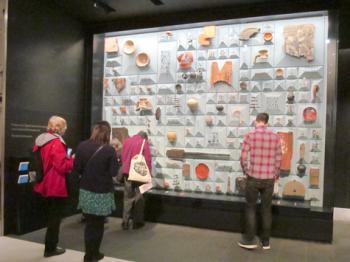London - Temple of Mithras the Bull Slayer
This item appears on page 38 of the August 2019 issue.
During the 1940-1941 Blitz, much of the area called The City, London’s historic center as well as its central business district, was destroyed. Years after the end of World War II, bombed-out sites were still being excavated. In 1952-1954, one of these sites, located on Walbrook between Cannon Street and Queen Victoria Street in the heart of The City, yielded a remarkable discovery buried 23 feet below the surface: the remains of a Roman temple.
On the last day of the excavation, the carved head of a statue was unearthed and identified as the god Mithras. Archaeologists concluded that the temple found deep within the earth was a Mithraeum.
Londinium before the Mithraeum
The Walbrook Mithraeum has been dated to about AD 240. Before I explain what a Mithraic temple was, it is important to go back 200 years before this temple was built to AD 43, when the Romans conquered Britain, 98 years after Julius Caesar invaded the island.
Shortly after the conquest, the Romans founded Londinium near the river Walbrook, which flowed into the Thames. The revolt of the Celtic Iceni under their queen, Boudica, was put down in AD 60-61 after the Iceni had destroyed the fledgling town. London grew rapidly in the following decades, doubling in population within 60 years after it was founded.
Among other structures, a forum, an amphitheater, temples and bathhouses were built for the soldiers, merchants and native Britons who settled within the expanding city.
The god Mithras
Among the temples built was one dedicated to Mithras, a god at the center of a religious cult that may have been imported from India by way of Persia. This cult flourished throughout the Roman Empire from approximately the 1st to the 4th centuries AD.
Mithras represented strength and loyalty and was often depicted as a bull slayer. His cult, restricted to men, was secret and was observed in dark, windowless temples meant to resemble caves, since Mithras was supposedly born in a cave.
Mithras’ temple
The Mithraeum uncovered in Walbrook is relatively small, 59 feet by 26 feet, capable of holding perhaps 30 people. Within was a central space, the nave, with benches lining its two longer walls and with a semicircular apse at the west end, where a statue of Mithras was displayed. Men would gather there for the secret rites centering on events in Mithras’ life and, perhaps, to share ritual communal meals.
It was probably early in the 4th century that the temple collapsed, along with it the practice of Mithraism on this site. Although another temple was erected later, it was not dedicated to Mithras, and later in the 4th century it too disappeared. Soon thereafter, around AD 410, Roman dominance in Britain ended, culminating with the demise of the Roman Empire in AD 476.
1962 temple
Traces of the Mithraic temple disappeared over succeeding centuries. Layer upon layer of London’s soil and debris — 16 centuries of it — covered the site until 1952, when the temple emerged from the devastation of World War II.
In 1962, the temple was moved and reconstructed on top of a car park (of all places) about 330 feet from its original location.
2017 temple
In 2010, Michael Bloomberg, mayor of New York City from 2002 to 2013 and founder/owner of Bloomberg Limited Partnership, purchased the land where the temple had originally stood in order to build his European headquarters. The decision was made to return the temple to its original location, incorporating it into the new building. The London Mithraeum Bloomberg SPACE opened to the public in November 2017.
During excavation, over 14,000 objects were found, many very well preserved because of soil conditions. Some of these items are now displayed on the museum’s ground floor as you enter, including a tiny amber gladiator’s helmet once used as an amulet, as well as coins, a sandal and a wooden door.
Unique tablets
Most interesting — and, arguably, most important — were the wooden tablets found, part of a collection of more than 400. Wooden tablets were coated with beeswax, on which one could write using a metal stylus. Sometimes the writing was inscribed so strongly on the beeswax that it went straight through to the wood beneath, thus making it possible for us to read what was written 2,000 years ago.
These tablets are legal documents and business “invoices.” One such tablet is reputedly the earliest handwritten document found in Britain. Dated January 8, 57 (two centuries before the Mithraic temple was constructed), the tablet records that Tibullus promised to pay 105 denarii to Gratus for goods received. Back in AD 57, 105 denarii was no small sum; it equaled about six months’ pay for a Roman soldier.
On the mezzanine level below are explanations of the cult of Mithras.
Today’s Mithraic temple
On the level below the mezzanine lies the reconstructed foundations of the 3rd-century-AD temple of Mithras. It is strikingly presented with strategic lighting and even mist in the air to give visitors a feel of what it might have been like to enter a damp, dark, cave-like Mithraic temple.
Visitors can walk along the perimeter of the temple on a raised platform past the apse where a statue of the god once stood. The lighting, dimming from bright to near dark, adds to the slightly eerie atmosphere, as does the recording of chanting voices.
To this day, no one knows for sure what rites were practiced in these Mithraic temples, so visitors can let their imaginations roam at will.
If you go…
London Mithraeum Bloomberg SPACE (www.londonmithraeum.com) is located at 12 Walbrook in The City. Closed Monday, it is open 10 to 6 Tuesday to Saturday and 12 to 5 Sunday. The museum is also open 10 to 8 on the first Thursday of each month.
Admission is free, but it is wise to book a timed admission slot online well in advance, since the number of visitors allowed inside the reconstructed temple is limited.
For my husband and me, our home away from home for our October 2018 visit to London was a “classic” 2-bedroom, 2-bathroom apartment in Knightsbridge at 19 Beaufort Gardens, located in a tree-lined cul-de-sac two blocks from Harrods.
Elegant and quiet (despite being a block away from busy Brompton Road), the apartment is a 5-minute walk from Beauchamp Place, full of restaurants, including San Lorenzo (Italian), Layalina (Middle Eastern) and Borscht ’n’ Tears (Russian), our favorites.
We rented through London Connection (phone, in the US, 801/393-9120, www.londonconnection.com), which offers a select collection of flats in other areas of London as well. Our flat cost $6,120 for 17 nights.


